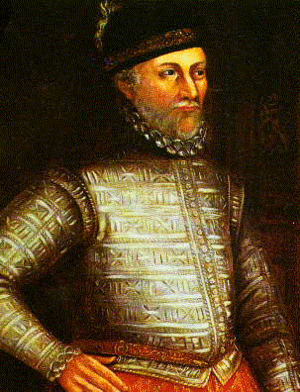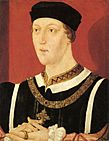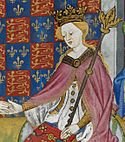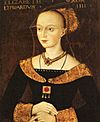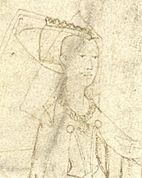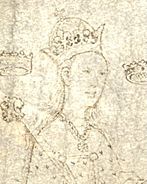Richard Neville, 16th Earl of Warwick facts for kids
Quick facts for kids
Richard Neville
|
|
|---|---|
| 16th Earl of Warwick | |
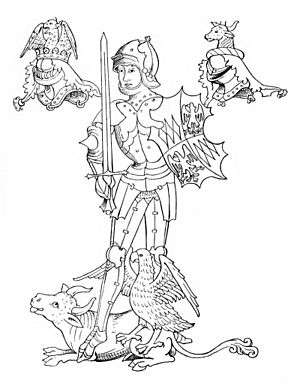
Warwick as drawn in the Rous Roll. He displays on his shield the arms of Montagu quartering Monthermer. The bull's head is the crest of the Neville family, the eagle is the crest of Montagu.
|
|
| Tenure | 23 July 1449 – 14 April 1471 |
| Predecessor | Anne Beauchamp, 15th Countess of Warwick |
| Successor | Edward Plantagenet, 17th Earl of Warwick |
| Other titles | 6th Earl of Salisbury 8th & 5th Baron Montagu 7th Baron Monthermer |
| Other names | Warwick the Kingmaker |
| Known for | Influence during the Wars of the Roses |
| Born | 22 November 1428 |
| Died | 14 April 1471 (aged 42) Barnet, Hertfordshire |
| Buried | Bisham Abbey, Berkshire |
| Nationality | English |
| Residence | Middleham Castle, et al. |
| Locality | Warwickshire, Yorkshire |
| Wars and battles | |
| Offices | Captain of Calais Lord High Admiral of England Steward of the Duchy of Lancaster |
| Noble family | Neville |
| Spouse(s) | |
| Issue | |
| Parents | Richard Neville, 5th Earl of Salisbury (father) Alice Montagu, 5th Countess of Salisbury (mother) |
| Signature |  |
Richard Neville, 16th Earl of Warwick, also known as Warwick the Kingmaker, was a very powerful English nobleman. Born in 1428, he became one of the richest and most influential people in England. He was a key leader in the Wars of the Roses, a series of civil wars fought over who should be king of England.
Warwick earned his nickname "the Kingmaker" because he helped put two different kings on the throne. First, he supported the Yorkist side and helped Edward IV become king. Later, he switched sides to the Lancastrians and brought Henry VI back to power. This made him a central figure in the politics of his time. He died in battle in 1471, at the age of 42.
Contents
Early Life and Family Power
Richard Neville came from the powerful House of Neville family. They were important in England's wars against Scotland. Richard's father, also named Richard Neville, became the Earl of Salisbury. This was through his marriage to Alice, who inherited the title.
Richard Neville, the future Kingmaker, was born on November 22, 1428. When he was only eight years old, in 1436, he married Lady Anne Beauchamp. Anne was the daughter of the Earl of Warwick. This marriage meant Richard would inherit not only his father's lands but also a huge amount of wealth from the Beauchamp family.
His wealth grew even more when Anne's brother, Henry, died without leaving a direct heir. This made Richard the Earl of Warwick through his wife. He became one of the wealthiest nobles in England. However, he had to fight in court to keep some of these lands, especially against Edmund Beaufort, Duke of Somerset.
By 1445, Richard had become a knight. He served King Henry VI in the north of England. At first, he supported King Henry VI.
The Wars of the Roses Begin
Trouble at Court
In 1453, a big problem started between Warwick and the Duke of Somerset. Somerset was given control of some land that Warwick believed was his. Around the same time, King Henry VI became very ill. Since the king couldn't rule, Somerset, who was a favorite of the king and Queen Margaret, took control of the government. This put Warwick at a disadvantage.
Because of this, Warwick decided to join forces with Richard, Duke of York. York was a powerful noble who also disagreed with the king's government. In 1454, the Duke of York was made "Protector of the Realm." This meant he was in charge while the king was sick. Warwick and his father, Salisbury, supported York.
However, King Henry got better in 1455. Somerset returned to power. Warwick, York, and Salisbury gathered their armies. They marched towards London and met the king's forces at St Albans. This was the First Battle of St Albans, the first major fight in the Wars of the Roses. It wasn't very bloody, but it was important. The king was captured, and Somerset was killed.
Fighting Continues
After the battle, York became Protector again, but not for long. In 1456, Queen Margaret convinced the king to take back control. Warwick became York's main ally. He was given a very important job: Constable of Calais. Calais was a French town controlled by England, and it had England's largest army. This job gave Warwick a strong base of power.
Queen Margaret saw Warwick as a threat. She tried to cut off his supplies. But in 1457, a French attack on Sandwich made the king realize he needed Warwick. Warwick was given money to protect Calais and the English coast. He even attacked Spanish and German ships, which was like piracy, but it made him popular. He also made friends with leaders in France and Burgundy. Warwick was building a strong military reputation and important international connections.
Yorkist Victory

In 1459, Warwick returned to England to meet York and Salisbury. Their armies were defeated at Ludford Bridge. Many of their soldiers didn't want to fight against the king. York fled to Ireland, and Warwick and Salisbury went back to Calais.
In 1460, Warwick, Salisbury, and York's son Edward (the future King Edward IV) landed in England. They marched to London. At the Battle of Northampton, King Henry VI was captured. Many important Lancastrian leaders were killed.
York arrived from Ireland and tried to claim the throne. But the nobles in Parliament didn't agree. They made a compromise called the Act of Accord. King Henry VI could remain king for his life, but his son would not inherit the throne. Instead, York would become king after Henry.
This agreement didn't last. In December 1460, at the Battle of Wakefield, York was killed. Warwick's father, Salisbury, was also executed. Warwick marched north to fight, but he was defeated at the Second Battle of St Albans. He then joined forces with Edward, York's son, who had just won a battle.
Warwick and Edward quickly went to London. The people of London supported them. On March 4, 1461, Edward was declared King Edward IV. The new king and Warwick then went north to fight the Lancastrians. Warwick was injured the day before the Battle of Towton, so he might not have fought much. This battle was very bloody, but the Yorkists won completely. Many Lancastrian leaders died. Queen Margaret, King Henry, and their son fled to Scotland. Edward IV returned to London for his coronation, and Warwick stayed to bring peace to the north.
At the Height of His Power
Warwick's Influence Grows
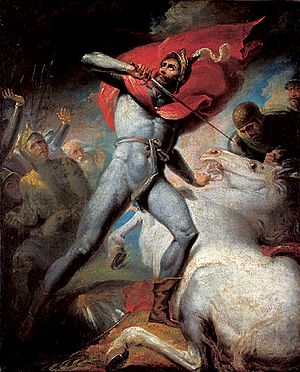
After Edward IV became king, Warwick's power was immense. He inherited his father's lands and wealth, making him incredibly rich. His yearly income from his lands was over £7,000, more than anyone else in England except the king.
Edward IV gave Warwick many important jobs. He remained Captain of Calais, became High Admiral of England, and Steward of the Duchy of Lancaster. Warwick's brothers also gained power. His brother John was made Warden of the East March, and his brother George became Archbishop of York.
By late 1461, rebellions in the north were stopped. In 1462, Warwick arranged a truce with Scotland. When Queen Margaret invaded England with French troops, Warwick organized the recapture of castles she had taken. He then traveled south to attend Parliament.
However, the north rebelled again. Warwick returned and stopped the rebellion. This time, the rebel leaders were executed. Warwick also negotiated truces with Scotland and France, bringing more stability to England.
Growing Problems with the King
Warwick had been trying to arrange a marriage for King Edward with a French princess. This would have created a strong alliance with France. But in September 1464, Edward revealed a secret: he was already married to Elizabeth Woodville.
This secret marriage deeply offended Warwick. Not only were his plans ruined, but the king had kept it a secret from him. Warwick had been unknowingly misleading the French. For Edward, this marriage might have been for love, but it also helped him build up the Woodville family's power, separate from Warwick's influence. This made Warwick lose some of his power at court.
Even so, Warwick was still important. He escorted the captured King Henry VI to the Tower of London in 1465. But tensions continued to grow. Warwick was sent to negotiate with France and Burgundy. He preferred an alliance with France, while Edward's new father-in-law, Richard Woodville, preferred Burgundy. Edward secretly signed a treaty with Burgundy, making Warwick's negotiations with France pointless.
Then, Warwick's brother George was removed from his job as chancellor. Edward also refused to let Warwick's daughter Isabel marry Edward's brother, George, Duke of Clarence. It became clear that the Woodville family was replacing Warwick as the most influential family at court.
By 1467, there were rumors that Warwick was thinking of joining the Lancastrians. He denied it, but discontent with Edward's rule was growing. Warwick saw this as an opportunity.
Warwick Changes Sides
Rebellion Against Edward IV
Warwick decided to start a rebellion in Yorkshire. He secretly convinced King Edward's younger brother, George, Duke of Clarence, to join him. Clarence was ambitious and jealous of his older brother.
In July 1469, Warwick and Clarence went to Calais, where Clarence married Warwick's daughter, Isabel. They then returned to England and gathered supporters. The king's forces were defeated at the Battle of Edgecote. Many of Edward's allies, including Earl Rivers (Edward's father-in-law), were killed.
Warwick then captured King Edward IV and imprisoned him first at Warwick Castle and then at Middleham Castle. However, it was difficult to rule without the king. There was too much disorder. So, Warwick had to release Edward IV in September 1469.
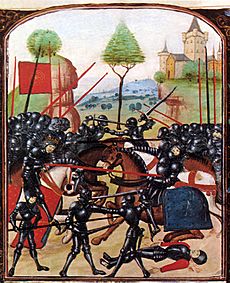
For a few months, Warwick and the king tried to get along. But Edward gave the earldom of Northumberland back to Henry Percy, which angered Warwick's brother Montagu. Warwick then tried to trap the king in Lincolnshire, but Edward discovered the plot and escaped.
Warwick and Clarence fled to France. There, King Louis XI of France helped Warwick make peace with Queen Margaret of Anjou. As part of this new alliance, Warwick's daughter Anne would marry Margaret's son, Edward, Prince of Wales. Their goal was to put King Henry VI back on the throne.
Warwick started another uprising in the north. While King Edward was away, Warwick and Clarence landed in England in September 1470. Many people joined Warwick, including his brother Montagu, who was unhappy with Edward. This time, the trap worked. As Edward rushed south, Montagu's forces approached from the north, surrounding the king. On October 2, Edward fled to Burgundy.
King Henry VI was restored to the throne, with Warwick acting as the true ruler. In November, Edward IV was stripped of his lands and titles.
Warwick's Death
However, international events changed everything. The Duke of Burgundy, Charles the Bold, gave Edward IV an army to reclaim his throne. On March 14, 1471, Edward landed back in England.
Warwick was waiting for Queen Margaret and her son to bring more soldiers from France, but bad weather delayed them. At this point, Edward's brother Clarence, who realized he had made a bad deal with the Lancastrians, switched sides again and rejoined Edward. This weakened Warwick's position.
Warwick pursued Edward. On April 14, 1471, their armies met at Barnet. A thick fog caused confusion, and the Lancastrian army accidentally attacked its own men. Warwick tried to escape the battle but was knocked off his horse and killed.
What Happened Next
Warwick's body, along with his brother Montagu's, was displayed in London to show everyone they were truly dead. Then they were buried at Bisham Abbey.
Soon after, on May 4, 1471, Edward IV defeated the remaining Lancastrian forces at the Battle of Tewkesbury. Prince Edward, Henry VI's son, was killed there. King Henry VI also died in the Tower of London shortly after. With no direct Lancastrian heirs left, Edward IV was able to rule peacefully until his death in 1483.
Warwick had no sons. His important jobs and lands were divided between King Edward's brothers: George, Duke of Clarence (who was married to Warwick's daughter Isabel), and Richard, Duke of Gloucester (who later married Warwick's other daughter, Anne). Clarence received the earldoms of Warwick and Salisbury.
When Richard, Duke of Gloucester, married Anne Neville in 1472, a dispute broke out between him and Clarence over Warwick's inherited lands. They eventually divided the land. However, Clarence was still unhappy. In 1477, he plotted against his brother the king again. This time, Edward IV had him executed.
Warwick's Place in History
Historians have different opinions about Richard Neville. Some early writings saw him as a great man, loved by the people, who was betrayed by the king he helped. Other writings, especially those ordered by Edward IV after Warwick's death, saw him more negatively. They described him as proud and selfish, someone who made and unmade kings as he pleased.
Over time, the negative view often became more popular. Writers in the 18th and 19th centuries criticized him for getting in the way of a strong, central monarchy. David Hume, a famous historian, called Warwick "the greatest, as well as the last, of those mighty barons who formerly overawed the crown." This meant Warwick was the last of the powerful nobles who could challenge the king's power.
More recent historians try to understand Warwick based on the rules and ideas of his own time. They point out that the insults Warwick received from King Edward, like the secret marriage, were very serious. Warwick's importance in national affairs was not just his imagination; other European leaders also saw him as very powerful.
His actions were not always seen as wrong by people at the time. In fact, Warwick was more popular than the king when he first rebelled in 1469. However, it was also impossible for Edward to truly be king while Warwick remained so powerful. A conflict between them was bound to happen.
Some historians from Burgundy, like Philippe de Commynes, had a negative view of Warwick. They said he was wise and cunning, and very rich, but also very hated. They also suggested he wasn't as brave as his brother John or King Edward.
Warwick in Stories and Shows
Richard Neville, the Earl of Warwick, has appeared in many plays, books, and TV shows.
Plays
Books
- Harry Turtledove, Opening Atlantis (2007)
- Philippa Gregory:
- The White Queen (2009)
- The Kingmaker's Daughter (2012)
- Sharon Kay Penman, The Sunne in Splendour (1982)
TV Shows
- The White Queen (2013): Warwick was played by James Frain.
- Britain's Bloody Crown (2015): Warwick was played by James Oliver Wheatley.
- The Hollow Crown, Henry VI Part 1 and Henry VI Part 2 (2016): Warwick was played by Stanley Townsend.
Coat of Arms
The Earl of Warwick's coat of arms was very detailed. It showed symbols from seven different families. These included the arms of his father-in-law, the Earl of Warwick, and his own family, the Nevilles. The Neville arms also showed a special design that meant they were related to the royal House of Lancaster. This was because Warwick's grandmother was Lady Joan Beaufort, whose father was John of Gaunt, a son of King Edward III.
See also
- Percy–Neville feud
- Kingmaker board game


